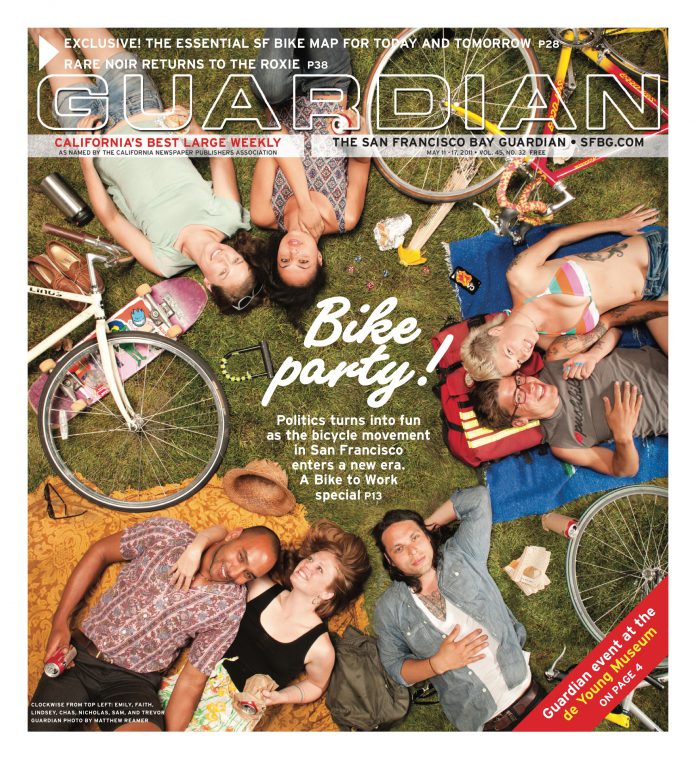arts@sfbg.com
The the sleek, the sublime, and the serendipitous hold each other aloft in Smuin Ballet’s spring concert, which runs at Yerba Buena Center for the Arts through this coming weekend and then moves to Walnut Creek (May 20-21) and San Mateo (May 25-29). Artistic Director Celia Fushille’s job is to hang on to the Michael Smuin fans and bring in new audiences wanting to see other approaches to choreography. She’s on the right track. Overall, the program, with Cho-San Goh’s much praised, little seen Momentum, the premiere of Amy Seiwert’s Requiem, and Smuin’s bonbon To The Beatles, made for a well balanced, decently performed evening of contemporary ballet.
Seiwert faced what looked like an impossible task: choreographing one of Western music’s sublime choral works, Mozart’s unfinished Requiem. The piece is burdened with all kinds of rigmarole about authenticity, a mysterious visitor, and his connection to Mozart’s death. Additionally, this is a deeply religious, apocalyptic piece of music about the “days of wrath” and a “just and avenging God,” an alien language for many 21st century listeners.
Wisely, Seiwert stayed on the human level. Her stoic Requiem explores the inexorable journey toward death in a manner that is profoundly respectful of the music. She may, however, have restricted herself too much emotionally. creating a chasm between music and dance. Particularly toward the end, when she was trying to approximate a suggestion of transcendence, the choreography didn’t quite convince. Alexander V. Nichols’ design of columns of light and glimpses of an unseen space — and a body being grasped by unseen hands — seemed almost too overt.
Mozart’s Requiem is dramatic, even operatic; Seiwert’s is a quiet meditation on the process of dying — as influenced by Elizabeth Kübler-Ross’ five stages of grief, which the choreographer claims as an inspiration. In the end Seiwert returns her dancers to the beginning to start the process anew.
Despite what probably is a mismatch between music and dance, Seiwert’s accomplishment is considerable. Her Requiem is a quietly brave and thoughtful interpretation of a great piece of music. She expertly worked with a vocabulary that included a resonant use of the upper body and a gestural language for the arms that sometimes approximated hieroglyphs. Movement motives returned and metamorphosed into rich textures. A sense of loss and loving support pervaded the multiple drops, supports, and lifts. It all started with Erin Yarbrough-Stewart spreading her arms to raise the crumbled performers to begin the dance.
Goh was a Singapore-born choreographer who died of AIDS at 39, in 1987, in the middle of what had been a highly successful career. Some had great hopes for him as “the next Balanchine.” So it was good to see his Momentum, set to Prokofiev’s Piano Concerto No. 1 in D Flat — notable for its highly percussive piano writing — quite ignored by the choreography.
Set on two primary and three secondary couples, Momentum is striking for the way its liquid and spacious design suggests an ensemble much larger than the mere 10 dancers who keep leaping from the wings. The lead couples smoothly glide in and out of the ensemble, suggesting quasi-egalitarian rather than hierarchical relationships. The costumes — shiny white unitards with black sashes for everyone — enhanced Momentum‘s democratic aspirations. The nonstop work thrives in an attractive windblown environment in which a circle evaporates into duets and men and women confront each other across space only to hook up with each other again. Symmetry and mirror imaging — traditional structural procedures — abound, though Goh often tries to hide them. It’s all very attractive — very balletic, very contemporary — though not very exhilarating.
Yarbrough-Stewart and Jonathan Powell, a fine addition to the company this season, danced the allegro duet; newcomer Jane Rehm, a lovely refined dancer, paired with Travis Walker for the adagio. Momentum‘s choreography is highly exposed — all the time. It would benefit from a more refined performance.
Smuin’s take on the Beatles is slight. It shows the choreographer’s second love, show business, and was an opportunity for the dancers to shine in soft-shoe routines (Powell and Shannon Hurlbut), high kicks (Rehm), tap (Hurlbut), and acrobatics (Yarbrough-Stewart). Former San Francisco Ballet dancer Jonathan Mangosing, however, was a smash in his louche rendering of “Come Together.”
SMUIN BALLET
Wed/11–Fri/13, 8 p.m.; Sat./14, 2 and 8 p.m.;
Sun./15, 2 p.m.; $20–$62
Yerba Buena Center for the Arts
701 Mission, SF
(415) 978-2787

